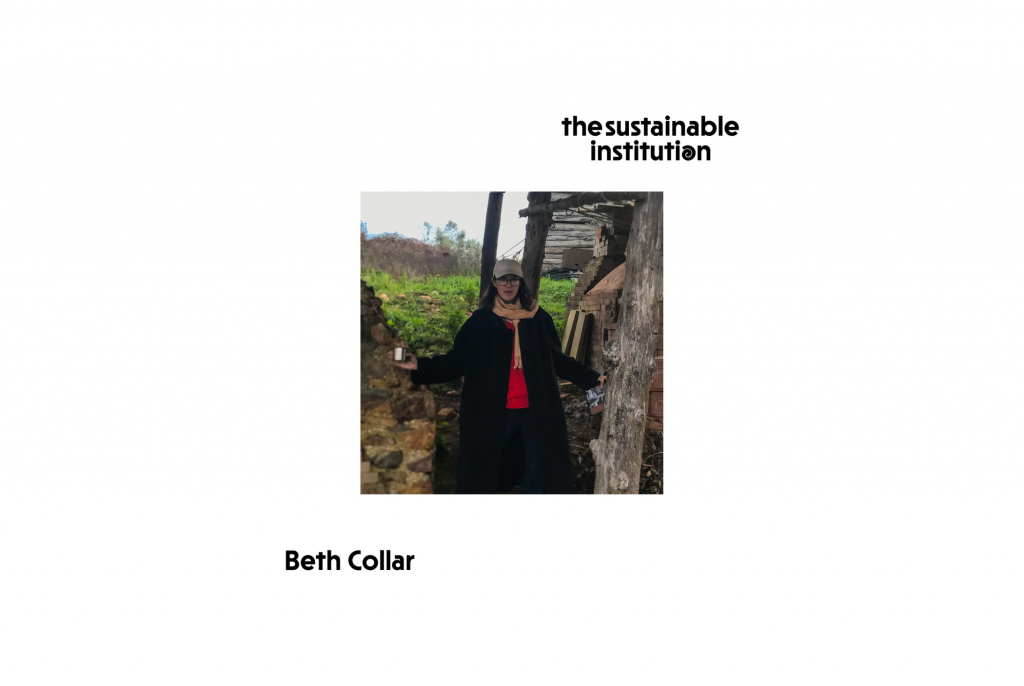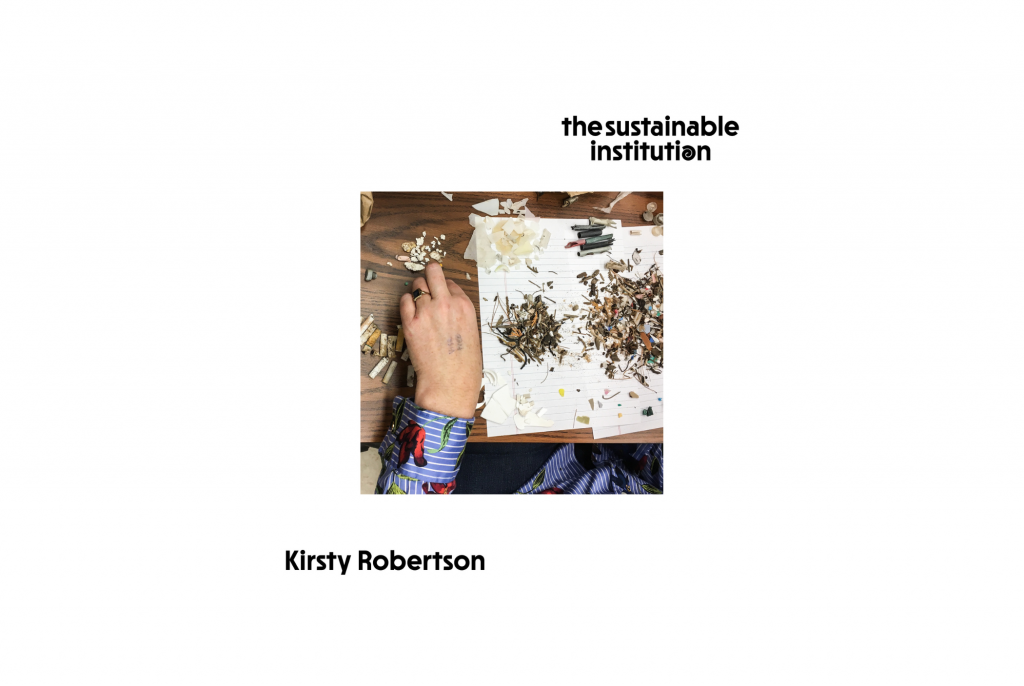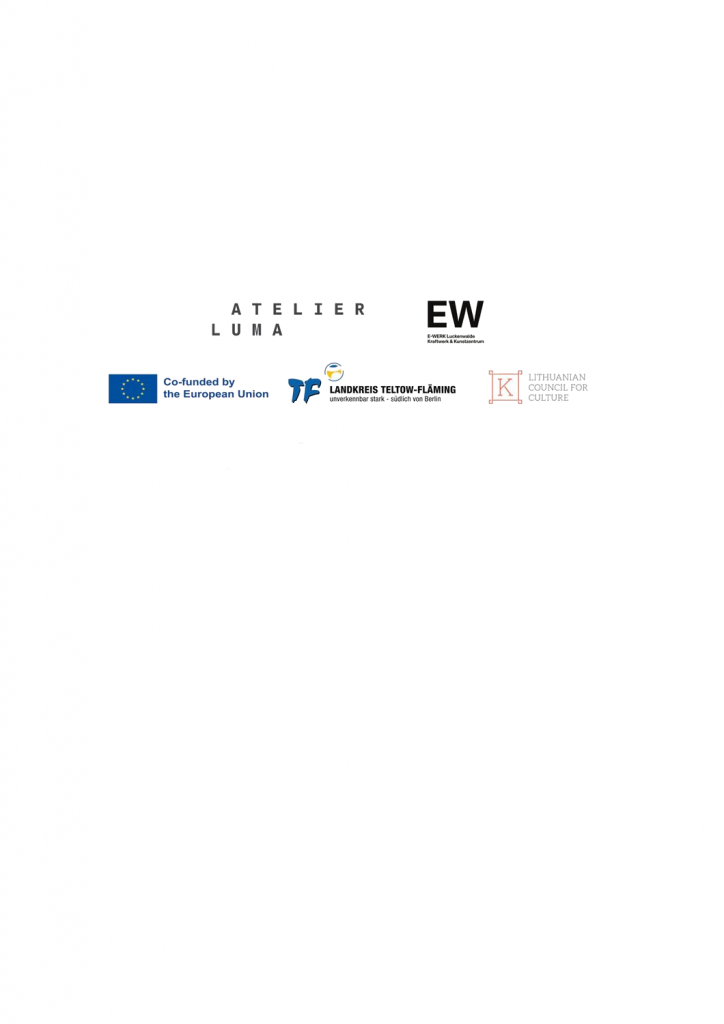Residents for ‘the sustainable institution’ announced
Rupert, E-WERK Luckenwalde and LUMA Arles announced the successful creative practitioners for the sustainable institution interdisciplinary artist residency programme, specifically focused on institutional sustainability, co-funded by The European Union. The programme is a call to action to innovate new sustainable approaches and stimulate human, economic and ecological change to the cultural landscape.
The successful artists are:
— bones tan jones will be in residence at Rupert Vilnius;
— Beth Collar will be in residence at E-WERK Luckenwalde;
— Kirsty Robertson and other members of the Synthetic Collective (SC) and the Centre for Sustainable Curating (CSC) will be in residence at LUMA Arles.
The artists were selected by a jury, which included Lucia Pietroiusti (Head of Ecologies at the Serpentine Galleries), Kim Kraczon (Conservator of modern materials and contemporary art specialising in sustainable solutions for cultural heritage, Director of Materials at Ki Culture and Advisor at Gallery Climate Coalition), Mae-ling Lokko (Architectural scientist, designer and educator), Asad Raza (Artist), Jan Boelen (Artistic Director of Atelier LUMA), Viktorija Šiaulytė (Rupert Director) and Helen Turner (E-WERK Artistic Director). The successful applicants will now be mentored by the jury over a six month research and development period, with a studio at their respective institution between March–April 2024 and a workshop programme to take place in SALT, Istanbul in 2024. All information will be hosted on www.sustainable-institution.com.
Each artist will receive a 20.000 EUR grant intended to provide support towards the research and development of their prototype, an early sample, model or idea of a concept or process towards sustainable exhibition making. the sustainable institution artist residency is an opportunity for artists to produce new solutions in the fight against climate change and mitigate the environmental burden of exhibition making.
🌀
bones tan jones will be in residence at Rupert Vilnius
Prototype: Herbal, plant and magical guide, working towards a sustainable performative practice
Mentor: Asad Raza (Artist)
The planned work is Parasites of Pangu 2.0 (working title)
The first iteration of Parasites of Pangu was performed at the Serpentine Galleries in London in 2019 and has since evolved and taken many forms: Sculpture, Installation, 2D works, Film and Writing. bones tan jones will use all these forms to re-imagine the opera, coinciding with the publication of the written opera score/novel, which also takes the form of a guide to herbs, plants and magic.
Parasites of Pangu tells the story of 5 trans nomads, who were reborn onto a wretched earth. Through speculative fiction, sci-fi and queer storytelling, this opera weaves ancient Chinese mythologies, herbal knowledge and magical thinking to paint a tapestry of inspiration and hope of building new worlds in community, to the audience.
A new body of paintings and sculptures is being developed that will also serve as a stage for the opera performance. The paintings will tell the story of the myth, while the sculptures will take figurative forms reminiscent of war memorials found on plinths in colonial cities, except that they will depict trans people, queer people, disabled people, all in positions of power, showing the resilience of their/our struggle.
Bones Says:
I feel very blessed to be awarded this residency, with the opportunity to delve into the beautiful landscape of Vilnius. The support from the sustainable institution programme will help me in expanding the world of my opera, Parasites of Pangu, in all its multi dimensional forms, while giving me time and space to work on a material practice that will be in dialogue with the landscape, and the potent and rich magic of Lithuania.
Mentor Asad Raza says:
I am looking forward to mentoring and learning from bone tan jones. Having attended their remarkable performance at the Bierpinsel tower in Berlin in 2022, I believe bones is able to channel energies and forces in a highly relevant and moving way. I believe the art world needs to work harder to include the ways and practices of bones and others who do not fit in the traditional categories of the plastic arts.
🌀
Beth Collar will be in residence at E-WERK Luckenwalde
Prototype: A large-capacity outdoor wood-fired kiln and a sequence of harvestable ‘tiny’ woodlands
Mentor: Mae-ling Lokko (Architectural scientist, designer and educator)
Collar’s proposal to the sustainable institution is an interleaving, reciprocal project consisting primarily of a large-capacity outdoor wood-fired kiln and a sequence of harvestable ‘tiny’ woodlands. Underlying all aspects of the project is a sustainable and sustaining community. The project would seek to grow a community of kiln users who would learn ‘on the job’ and be able to teach others as time went on. The project would also require a wood store, to be replenished after every burn, covered work area and accommodation and facilities for overnight firing duties. This proposal seeks to reclaim the full production methods and humanise the firing process, connecting artists with their materials and processes in a more embodied way, and empowering them to run their own burns. By cultivating a space for collaboration and making, the proposal goes beyond the bricks of the kiln itself, fostering lasting connections that can have a sustained and positive impact on the artist scene in Berlin as well as providing a precedent for other similar projects elsewhere in Germany and beyond.
Beth says:
I’m very excited about what I’ll find out during the residency, and I’m very grateful to the sustainable institution and to E-WERK Luckenwalde for giving me this opportunity to build something that could be sustainable and regenerative in all senses of the words! In the project I am seeking to make a stronger connection between art making, our actual world and a spiritual world. My project seeks to build community, re-discover lost ways of making and to honour old gods and demons.
Mentor Mae-ling Lokko says:
In her poetic concept of the ‘tiny forest”, the wood-fired and earthen craft, Beth narrows the gap between energy extraction. Her proposal brings to the surface, the tension between today’s policies around fire and sustainable material practices across cultural institutions and the broader built environment. It was a wonderful experience to learn from both the jury and the exciting applicant pool about how wide-ranging and deep an institutions’ practice of sustainability needs to be. In the end, every component of our institutions need to be redesigned to new criteria; it’s a daunting yet highly exciting call-to-action.
🌀
Kirsty Robertson and other members of the Synthetic Collective (SC) and the Centre for Sustainable Curating (CSC) will be in residence at LUMA Arles.
Prototype: Acquisitions Contract, low-data solar powered website plan and materials guide
Mentor: Kim Kraczon (Conservator)
This proposal emerges from a collaboration between the Synthetic Collective (SC) and the Centre for Sustainable Curating (CSC), both located in the Great Lakes watershed of North America. The Centre for Sustainable Curating supports museum research, exhibitions, visual/digital production, and pedagogy focused on environmental and social justice. Located in the Department of Visual Arts at Western University (Canada), CSC projects focus on waste, pollution, and climate crisis, and the development of exhibitions and artworks with low carbon and waste footprints. The Synthetic Collective is an interdisciplinary collaboration among visual artists, humanities scholars, and scientists centred on plastic pollution in the Great Lakes watershed of North America (a massive system of lakes that holds more than 20 per cent of the world’s surface freshwater reserves). Crucial to the SC’s research methodology is the driving principle that artists and scientists conduct research together from the outset of the inquiry, and that research should not result in further environmental harm. The SC works to better connect scientific knowledge with cultural work, and to enrich artistic production with informed science. For this residency, the CSC and SC have come together to define and tackle the knowledge gaps in creating sustainable institutions, using their expertise in plastics, low-waste and low-carbon curating, pedagogy, and accessibility, as well as their location in a geographic region.
Kirsty explains:
We have worked together since 2014, successfully curating two major exhibitions focused on plastics and plastics pollution that developed and mobilized numerous low-environmental-impact strategies. Our proposal emerges from the fact that along the way, we have learned that capacities can look very different for large art galleries and small museums, though all belong to the same sector and all can benefit from making their practices more sustainable over the long term. With this in mind, we propose a holistic, scalable, and adaptable process of sustainable exhibition making that emerges from the guiding principles of repair, communication, and relationship-building.
Mentor Kim Kraczon says:
What excites me the most about collaborating with The Synthetic Collective as artists in residence in The Sustainable Institution is the challenge their work poses to prevailing standards in museum collections stewardship and resource intensive conservation conventions by granting artists the agency to sanction natural ageing processes of materials over time and ultimately determine the lifespan of their own artworks.
Between April and July 2023 each institution also presented an international symposium programme focused on sustainable change from an economic, humanitarian and ecological perspective. Next year, the programme will continue at E-WERK Luckenwalde with a weekend of talks, performances and live events, to be announced for May 2024. In tandem, Rupert , E-WERK and LUMA Arles have launched a digital toolkit in collaboration with Gallery Climate Coalition as an open resource and tool for culture to improve ecological, economic and human sustainability. As a culmination of the project the consortium of partners, jury, artists will co-curate a workshop programme at SALT Istanbul based on the idea of validating the prototypes for global use and implementation into institutions across Europe.
ABOUT THE ARTISTS
bones tan jones (b.93 Liverpool)
is a queer heretic whose work traverses materials, disciplines and time lines. raised in a church choir in the northwest of the UK, on the borderlands of mythical Wales and enchanted England, tan jones’s work has ne’er strayed far from the ecclesiastic rituals of worship, only in tan jones’s world, the church has been burnt, the yew trees thrive in the ashes, and god is trans. bones tan jones presents their living praxis optimystic dystopia as a spiritual practice. an eternal storyteller, alternative realities are explored through alter egos, retellings of ancient Chinese and Celticmythologies through creating; symphonies/ operas/ psalms/ triptychs/ sigils/ stele/ installations/ interventions/ interactive workshops. remaining open, so the ancestors can speak through, bones has collaborated with the ghosts of dead artists, unknowingly channelled ancient seal script inscriptions of their families’ clan symbol, and sung many a lullaby in the belly of trees thousands of years on this land. this, is the work. this, is the way. all tools, souvenirs and tales collected on the way are offered up to you, as an art, of sorts.
🌀
Beth Collar (b. Cambridge, England, 1984)
Solo projects include The Unforgiven, Sundy, London (2022), Basher Dowsing, von ammon co., Washington DC, U.S.A. (2021); SHANE, a collaboration with Elif Saydam, Zarinbal Khoshbakht, Cologne, Germany(2021); End Quote, stadium, Berlin (2020); Daddy Issues, Dilston Grove, London, with Matt’s Gallery and Southwark Park Galleries (2019); Retrogression, a collaboration with Eoghan Ryan, 427 gallery, Riga, Latvia (2019); Thinking Here Of How The Words Formulate Inside My Head As I Am Just Thinking, Waldo at Mathew Gallery, New York (2018); Cloaked Output Vol 2: Spirals of Focus, Primary, Nottingham (2018); Seriously, Mark Tanner Sculpture Award, Standpoint, London (2017); and 11/50, Fig2 at the ICA, London (2015). Recent performances have taken place at Why Words Now, Royal Danish Academy of Fine Arts and Art Hub Copenhagen (2021), CentrumCentrum, Szczecin, Poland (2020); Camden Arts Centre, London (2020). Group exhibitions include Doppel, two man show with Jesse Darling, A plus A, Venice, IT (2021), VON UTEN, two man exhibition with Shaun Motsi, Elvira, Frankfurt am Main, DE (2021), Kunstverein Kesselhaus, Bamberg, Germany (2020); Marlborough Contemporary, New York (2020); Bärenzwinger, Berlin (2019); Cell Project Space, London (2018); Kunstverein München, Munich (2017); and KW, Berlin (2016). Since 2015 Collar has been an associated artist with the charity Waterloo Uncovered. Collar’s solo show at the Westfälischer Kunstverein opened at the end of October.
🌀
The Centre for Sustainable Curating (SCS) and The Synthetic Collective (SC)
supports museum research, exhibitions, visual/ digital production, and pedagogy focused on environmental and social justice. Located in the Department of Visual Arts at Western University (Canada), CSC projects focus on waste, pollution, and climate crisis, and the development of exhibitions and artworks with low carbon and waste footprints. The Synthetic Collective is an interdisciplinary collaboration among visual artists, humanities scholars, and scientists centred on plastic pollution in the Great Lakes watershed of North America (a massive system of lakes that holds more than 20 per cent of the world’s surface freshwater reserves). Crucial to the SC’s research methodology is the driving principle that artists and scientists conduct research together from the outset of the inquiry, and that research should not result in further environmental harm. The SC works to better connect scientific knowledge with cultural work, and to enrich artistic production with informed science. For this residency, the CSC and SC have come together to define and tackle the knowledge gaps in creating sustainable institutions, using our expertise in plastics, low-waste and low-carbon curating, pedagogy, and accessibility, as well as our location in a geographic region of extreme weather and changing landscapes, as guiding factors in our contribution.
🌀
the sustainable institution is co-funded by the European Union, Teltow-Fläming and the Lithuanian Council for Culture.
Views and opinions expressed are however those of the author(s) only and do not necessarily reflect those of the European Union or the other granting authorities. Neither the European Union nor the granting authority can be held responsible for them.




